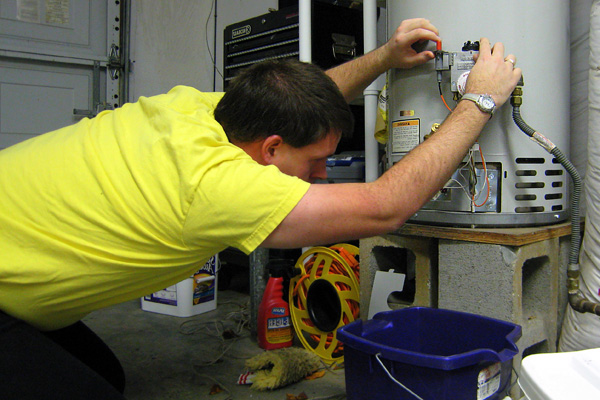
Did you know that a home water heater can have more than 60 gallons of water stored inside? During an emergency, this could provide you with backup supply of potable water that can be used to compliment whatever reserves that you have on hand. Accessing this water is not that difficult, and following the general steps below can give you an idea of how to take advantage of this opportunity (Emergency Water Storage Solutions).
Getting Started
The first step is to shut off the gas and turn off the electricity to the heater. Cut the power by unplugging it whenever possible, or by turning off switch in the circuit breaker. Almost every water heater have an on/off switch to stop the flow of gas, but you may need to turn off the valve along the line that supplies the heater in some cases. Never work on a hot water tank while the gas or electricity is still on.
Next, it is very important that you shut the water supply valve that feeds the tank with water from the mains. This will help to prevent the water in the tank from being contaminated by the source water following an emergency. There are times that municipal water will be contaminated for a short time after service is restored, and you want to protect your supply. Do this as soon as water service has been cut off. (How to gain complete energy independence)
Connecting the Drain Valve
Almost every water heater has some kind of drain pipe near the bottom. This is normally used for flushing when routine maintenance or repairs are being made. Many drain pipes come with threaded connectors that are designed to accommodate standard garden hoses. Attach the hose to the drain valve, as this is where you will get your water supply from. If you don’t have a threaded connection, improvise as best you can by using tape, putty, or even chewing gum to make the seal as leak-proof as possible.
Starting the Flushing
Don’t open the drain valve until the hose has been connected and inserted into the containers that will be storing the water. You can also use the water on an as-needed basis, collecting just enough to give you an on-demand supply. Next, turn on one of the hot water knobs at a faucet somewhere in the house. This will introduce pressure into the system that will push water out of the drain valve. Open the drain valve.
You only need to open the faucet until water starts to flow from the bottom of the tank, so having a helper to turn it off will help you to conserve water. You may also want to consider plugging the sink or connecting a hose to the faucet to collect any water that flows in order to minimize waste as well.
READ: Emergency Food and Water
The next step is to collect a small amount of water to check for quality. A lot of sediment can gather near the bottom, and you want it to settle as much as possible before draining. If you see some sediment accumulating in your test batch, close the valve and let the water settle for a couple of hours before starting again. You may also need to open the valve just enough to allow for a small amount of water to flow through in order to minimize the amount of sediment that comes out of the tank.
Once you’ve collected the water, you will need to purify it if necessary. This is particularly true if the water has been sitting in the tank for a prolonged period of time. If you have a test kit, check the quality before drinking. If the water is contaminated, boil it, add purification tablets or a little bit of chlorine bleach in order to make it safe for consumption.
You may be able to get enough water from a full tank to provide a week’s worth of supplies if you’re careful. This is why it is such a valuable source to tap into whenever possible. Take some time to get familiar with your hot water tank in order to know exactly what to do if you ever need to take advantage of this option, so you can use it to your advantage if the need ever arises (101waystosurvive.com).
Recommended:
Reynolds Solar Hot Water Heater
DIY Project – Tips on Saving Water
The vital self-sufficiency lessons our great grand-fathers left us
Make sure you like our
Self-sufficiency and Preparedness solutions recommended for you:
Backyard Liberty (Obama’s hidden agenda: more than just your guns…)
Survival MD (Knowledge to survive any medical crisis situation)
Food for Freedom (If I want my family to survive, I need my own food reserve)
Blackout USA (EMP survival and preparedness guide)



